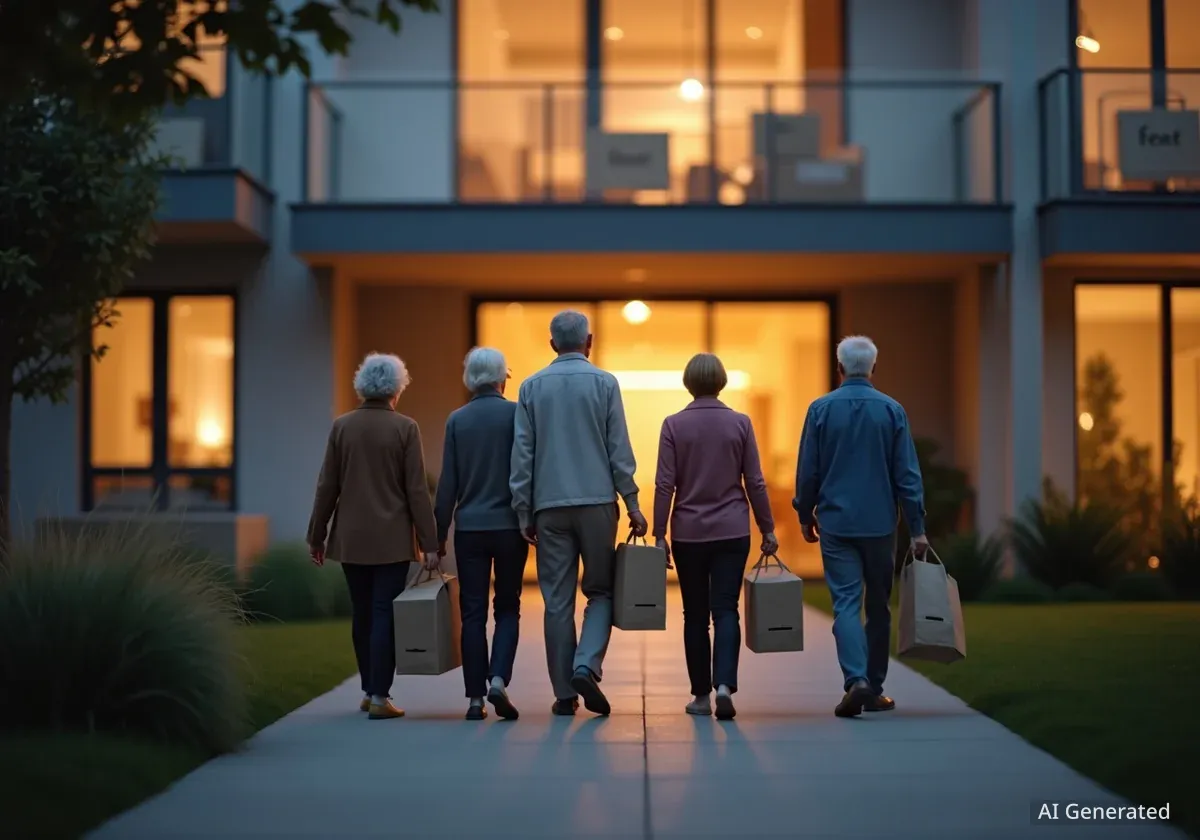A significant shift is occurring in the United States housing market as a growing number of adults over 65 are choosing to rent their homes. National data reveals a nearly 30% increase in older renters over the past decade, a trend mirrored in metropolitan areas like the Twin Cities, where this demographic now constitutes 15% of the rental population.
This change is driven by a complex mix of personal choice and economic necessity. While some retirees seek the flexibility and reduced responsibility of renting, others are pushed into the rental market due to financial constraints, highlighting a dual reality for seniors navigating their housing options in later life.
Key Takeaways
- The number of renters aged 65 and older in the U.S. grew by 2.4 million between 2013 and 2023, a jump of nearly 30%.
- In the Twin Cities, residents over 65 now make up 15% of all renters, an increase of almost 27% in the same period.
- The trend is driven by two main factors: retirees seeking a maintenance-free lifestyle and those who cannot afford homeownership.
- Many older renters on fixed incomes face financial risks, including sharp rent increases and housing instability.
A National Trend with Local Impact
The traditional image of retirement often involves owning a home outright. However, recent data indicates a notable departure from this norm. According to an analysis of U.S. Census Bureau data, the population of renters aged 65 and older has expanded significantly. In 2023, more than 10 million older adults were renters, representing 13.4% of the total renter population in the country.
This national pattern is clearly visible at the local level. In the Minneapolis-St. Paul metropolitan area, known as the Twin Cities, individuals over 65 now account for 15% of the renter base. This figure represents a substantial 27% increase since 2013, showing that the region is experiencing this demographic shift at a rate consistent with the rest of the nation.
By the Numbers: The Rise of Senior Renters
Between 2013 and 2023, the number of American renters aged 65 and older increased by 2.4 million people. This surge highlights a profound change in how seniors approach housing in their post-career years.
This growing segment of the rental market reflects broader economic and social changes. For some, the decision to rent is a deliberate lifestyle choice, while for others, it is the only viable option in a challenging housing market.
The Two Sides of Retiree Renting
The reasons behind the increase in older renters are twofold, creating a clear divide between those who rent by choice and those who rent out of necessity.
Renting as a Lifestyle Choice
For a segment of affluent retirees, renting offers a level of freedom that homeownership cannot. By shedding the responsibilities of property maintenance, they can redirect their time and money toward other priorities. This group is often looking to avoid the escalating costs associated with owning a home, such as property taxes, insurance premiums, and unexpected repair bills.
The desire for a more flexible lifestyle is a primary motivator. Renting allows for easier relocation to be closer to family, travel for extended periods, or move to a community with better amenities or healthcare access. The current housing market, characterized by high mortgage rates and a limited supply of homes for sale, has also made downsizing a less appealing financial move for many homeowners.
- Freedom from Maintenance: No need to worry about lawn care, snow removal, or costly repairs.
- Financial Simplicity: A predictable monthly rent payment simplifies budgeting.
- Flexibility: The ability to move easily to adapt to changing health or family needs.
- Access to Amenities: Many rental communities offer pools, fitness centers, and social activities.
Renting Out of Economic Necessity
In contrast, a significant number of older adults rent because they lack the financial resources to own a home. Decades of inconsistent income, economic downturns, or insufficient savings may have prevented them from ever buying a property or led to the loss of a previously owned home.
For this group, renting is not about choice but about survival. They are often on fixed incomes, making them particularly vulnerable to the volatility of the rental market. Sudden and steep rent increases can create immense financial pressure, forcing difficult decisions about essential expenses like healthcare and food.
Understanding 'Cost-Burdened' Renters
A household is considered "cost-burdened" when more than 30% of its gross income is spent on housing costs, including rent and utilities. This is a key indicator of housing affordability and financial stress. In Minnesota, more than half of all renters aged 65 and older fall into this category, signaling widespread financial strain.
These renters face an uncertain future. Without the equity of a home to fall back on, they have limited financial security and are more exposed to housing instability should their landlord decide to sell the property or raise the rent beyond their means.
Financial Realities and Market Conditions
The current real estate market presents challenges for everyone, but older adults on fixed incomes are especially affected. Low housing inventory and high prices have created a difficult environment for both buyers and renters.
"The hallmark of the real estate market these days is there are few good choices with low inventory and high prices — rental or owner-occupied," notes Chris Farrell, a senior economics contributor for Marketplace. This sentiment underscores the limited options available to many seniors.
While renting can protect retirees from the unpredictable costs of home repairs, it exposes them to the risk of rising rents. A 10% increase in rent can be a minor inconvenience for a high-earning household but a catastrophic event for a senior living on Social Security and a small pension. Such increases can force them to relocate, often moving them away from their established social networks and support systems.
For near-retirees with financial resources, experts suggest a careful analysis of renting versus owning. Calculating the long-term costs of both options is a crucial step in planning for a stable retirement. However, for those with limited wealth, the choice is often made for them by market forces beyond their control.
The Outlook for Senior Housing
As the Baby Boomer generation continues to age, the number of older renters is expected to keep growing. This demographic shift will place increasing pressure on the rental market to provide suitable and affordable housing for seniors.
The trend highlights a need for more diverse housing solutions that cater to the varying financial situations and lifestyle preferences of older adults. This includes everything from luxury apartment complexes with extensive amenities to more affordable, accessible housing options integrated into communities.
Ultimately, the rise of the retiree renter is a complex phenomenon. It reflects both a desire for a new, more flexible way of living in retirement and a stark reality of economic inequality that leaves many vulnerable. For older adults with resources, the pros and cons are worth careful consideration. For those without, the rental market remains a challenging and often precarious necessity.





